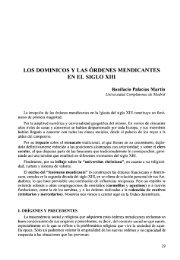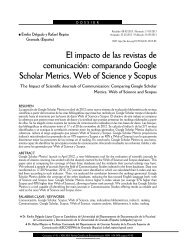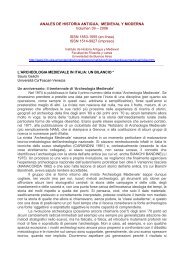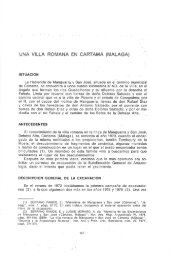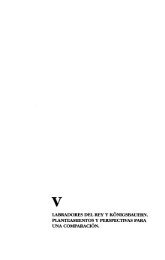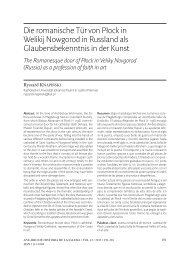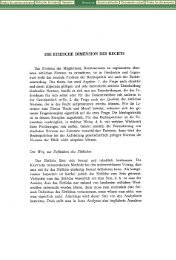Roslyn M. Frank 1.0. Introduction In the first chapter of this ... - Dialnet
Roslyn M. Frank 1.0. Introduction In the first chapter of this ... - Dialnet
Roslyn M. Frank 1.0. Introduction In the first chapter of this ... - Dialnet
Create successful ePaper yourself
Turn your PDF publications into a flip-book with our unique Google optimized e-Paper software.
120<br />
<strong>Roslyn</strong> M. <strong>Frank</strong><br />
recall <strong>the</strong> entity to which it was originally applied. Given that cultural knowledge<br />
is differentially distributed among <strong>the</strong> various members <strong>of</strong> a given cultural<br />
community, in <strong>this</strong> gradual process <strong>of</strong> semantic shift, <strong>the</strong>re are stages in which<br />
<strong>the</strong> primary meaning <strong>of</strong> <strong>the</strong> term is still present, i.e., when its frequency <strong>of</strong> occurrence<br />
is high enough that it might hold <strong>the</strong> second place for centuries, only to<br />
fall to last place and/or disappear entirely centuries later. What governs <strong>the</strong>se<br />
shifts appears to be a kind <strong>of</strong> complex, distributed interaction between speakers<br />
and <strong>the</strong>ir environment, an interaction that <strong>of</strong>ten can be reconstructed only after<br />
<strong>the</strong> fact, i.e., after <strong>the</strong> word has undergone major semantic shifts and, generally<br />
speaking, only in those cases where <strong>the</strong>re is sufficient written documentation so<br />
that <strong>the</strong> processes involved earlier can be charted.<br />
The aforementioned similarities holding between <strong>the</strong> nature <strong>of</strong> semantic shift<br />
and <strong>the</strong> kind <strong>of</strong> changes that take place over time in <strong>the</strong> case <strong>of</strong> ritual practice<br />
and belief allow us to develop a methodological approach that takes advantage<br />
<strong>of</strong> both types <strong>of</strong> shift. By <strong>this</strong> statement I refer to <strong>the</strong> fact that <strong>the</strong> current research<br />
project focuses on <strong>the</strong> meanings associated with <strong>the</strong> Basque term hamalau<br />
«fourteen» and <strong>the</strong> way that <strong>the</strong>se meanings can be traced across space and time,<br />
<strong>the</strong> way <strong>the</strong> linguistic artifact has been socio-culturally situated and <strong>the</strong> way that<br />
it has generated a set <strong>of</strong> interlocking cultural conceptualizations (Sharifian 2008).<br />
Thus, we need to keep in mind that <strong>the</strong> term hamalau projects a semantic field<br />
consisting <strong>of</strong> a number <strong>of</strong> interrelated meanings: it has a number <strong>of</strong> referents.<br />
Fur<strong>the</strong>rmore, it is deeply entrenched in Basque social practice, occupying a<br />
central place within an archaic belief system, one that holds that Basques descended<br />
from bears. Naturally, as has been asserted, <strong>this</strong> ursine cosmology is<br />
more congruent with an environmental setting <strong>of</strong> hunter-ga<strong>the</strong>rers. Therefore, if<br />
<strong>this</strong> assertion is correct, we are looking at a cultural complex that has been<br />
affected – recontexualized repeatedly over time – by several different kinds <strong>of</strong><br />
symbolic orders, including <strong>the</strong> worldview <strong>of</strong> pastoralists and agriculturalists,<br />
characterized by <strong>the</strong> domestication <strong>of</strong> animals and <strong>the</strong> eventual rise <strong>of</strong> <strong>the</strong> human-nature<br />
dichotomy. <strong>In</strong> <strong>this</strong> new symbolic regime we find <strong>the</strong> downgrading<br />
<strong>of</strong> non-human animals and <strong>the</strong> subsequent elevation <strong>of</strong> human animals to <strong>the</strong><br />
category <strong>of</strong> an entirely separate class <strong>of</strong> beings (<strong>Frank</strong> 2003, 2005; <strong>In</strong>gold 1995).<br />
Consequently, it would not be surprising to discover that at some point a<br />
confrontation took place between <strong>the</strong> ursine cosmology and <strong>the</strong> emerging anthropocentric<br />
framework that dominates today, and that over time <strong>the</strong>se encounters<br />
or interactions between <strong>the</strong> opposing worldviews would have set up a contest<br />
with respect to <strong>the</strong> manner in which «meaning» was assigned to <strong>the</strong> symbolic<br />
artifacts in question. Thus, <strong>the</strong> interpretation <strong>of</strong> <strong>the</strong> symbolic artifacts –



